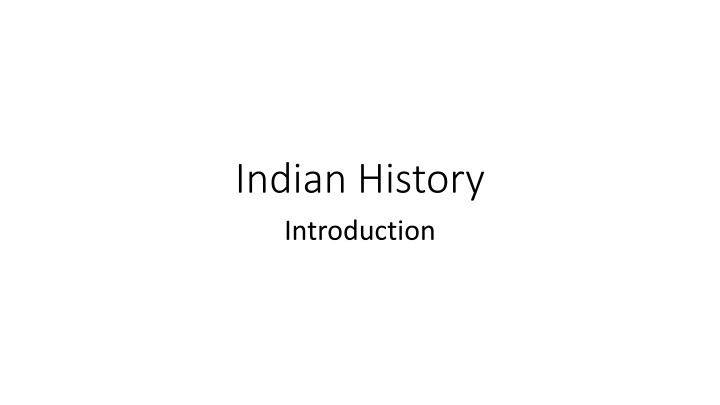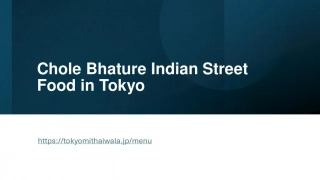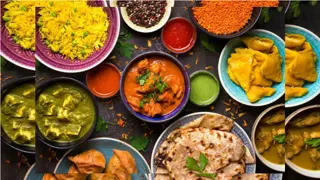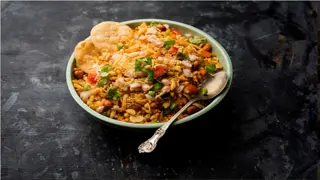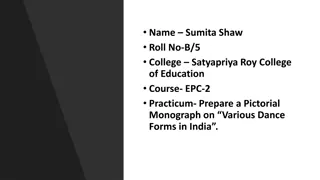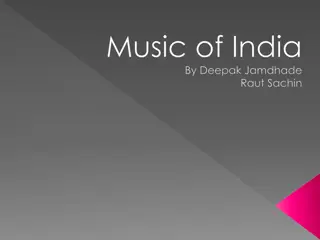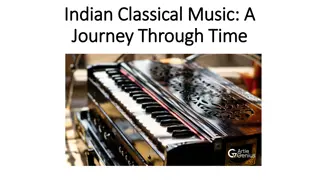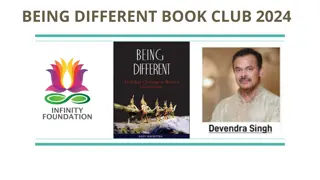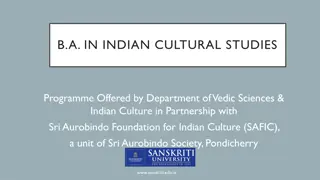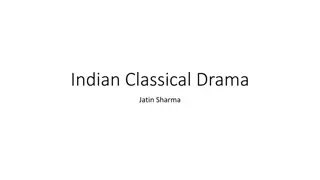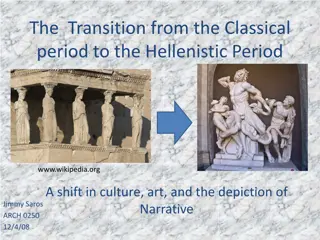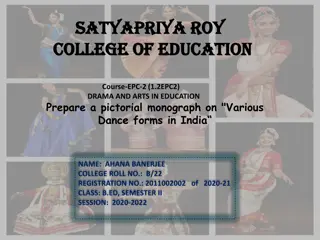Indian History Overview: Classical Patterns and Traditions
Indian history is rich and diverse, encompassing political, social, and cultural developments over thousands of years. Explore the classical patterns of South Asia, from ancient civilizations to empires, social divisions, and the evolution of political structures. Delve into the challenges, migrations, and absorption that have shaped India's history, highlighting the significance of diversity and pluralism in its cultural tapestry.
Download Presentation

Please find below an Image/Link to download the presentation.
The content on the website is provided AS IS for your information and personal use only. It may not be sold, licensed, or shared on other websites without obtaining consent from the author.If you encounter any issues during the download, it is possible that the publisher has removed the file from their server.
You are allowed to download the files provided on this website for personal or commercial use, subject to the condition that they are used lawfully. All files are the property of their respective owners.
The content on the website is provided AS IS for your information and personal use only. It may not be sold, licensed, or shared on other websites without obtaining consent from the author.
E N D
Presentation Transcript
Indian History Introduction
HISTORY Purpose today two fold Large Patterns Overview to ca. 1500 (where your textbook more or less begins) For Large Patterns Indian History: A Chronological Overview Making of Classical India 2500BCE -700 CE (3200 years) Making of Diversity 600 1800 CE (1200 years) Europeans 1500-1900 (400 years) Nationalism 1850-1947 (100 years) Since Independence (70 years) There are TWO main areas of HISTORY I would like to address POLITICAL-ECONOMIC and SOCIAL/CULTURAL as you will see, the two are related A theme running through all of these is DIVERSITY, how central it has been to the make up of India Some issues of interpretation, British and Nationalist interpretations of history, also come into the picture
Overview CLASSICAL PATTERN What does that phrase mean? The classical of South Asia must include developments relating to: POLITICAL: Kingship State formation, Empires SOCIAL : formations, Varna / Caste CHALLENGES : Upanishads, Buddhism, Jainism etc Migrations and Absorption KEY to this tradition is DIVERSITY and PLURALISM Long Term Pattern of CENTRALIZATION / DECENTRALIZATION REGIONAL and CULTURAL DIVERSITY Regional Kingdoms and Languages (700-1200 BCE) Islam 700 CE onwards: makes a new contribution, radical egalitarianism & refusal of Varna Delhi Sultanates 1200-1500 Mughals 1526-1857
CLASSICAL TRADITIONS: POLITICAL Earliest INDUS VALLEY CIVILIZATION, ca 2500 BCE, advanced urban CIVILIZATION. Replaced around 1500 BCE with nomadic one. Don t know quite HOW that transformation occurs. Nomads, calls themselves ARYA, speak a language called SANSKRIT POLITICAL: As society more complex, they had to be organized into STATES, into governments. Kingship Emerges out of lineage assemblies that used to make decisions STATES, fight over RESOURCES, or try to GET more resources. EMPIRES, by 230 BCE all India LAND main resource, but people already ON land, or in forests. Displacing occurs POLITICAL 2500-200 BCE
CLASSICAL TRADITIONS: SOCIAL Social divisions justified by ideology. For power. Nomads called themselves ARYA, defeated folks DASA An ideology of distinction was called VARNA. As nomads settle to agriculturalists and then towns, the 2-fold division changed to the 4-fold division we today call The Caste System [why all three words are wrong!] BRAHMIN, KSHATRIYA, VAISYA-VIS, SHUDRA. AND OUTCASTE The reason the idea spread, was 1. that it was good way for the powerful people to LEGITIMIZE and JUSTIFY their power. 2. Also, fairly flexible, A good way to INCORPORATE other groups. Between 1500 BCE and 700 CE, 2000 years, many groups enter Indian subcontinent, GREEKS, HUNS, CHINESE, MONGOL etc. Most INCORPORATED, by accepting their LEADERS as warrior and others according to status. New rulers claim they were KSHATRIYA, pay Brahmins to fabricate lineages. So POWER legitimized. Nice little nexus between the priests and warriors, mutual backscratching! More about this when you have questions, in the meantime read the following on course web page if interested Powerpoint: Caste, a historical approach British transformations and the caste system An older, but very interesting comparison of race in the US and caste in India SOCIAL 2500-700 CE
CHALLENGES TO THE CLASSICAL MODEL The same period that saw emergence of classical pattern also saw CHALLENGES to these ideas of Brahman superiority, BUDDHA, MAHAVIRA (founder of JAINISM) came from KSHATRIYA background, repudiate caste, Brahmin superiority UPANISHADS ca. 1000 BCE even earlier Period from circa 250 BCE to almost 700 CE (a millennium!!) is one where different empires rise and fall. Also a period when distinct geographical cultural regions emerge This is CRITICAL, because reflects a trend of CENTRALIZATION and DECENTRALIZATION. Nationalists say decentralization is bad, but, really regional efflorescence. Language, cultures, political kingdoms. Only from POV of MODERN STATE, whether colonial or national, is this a bad thing.
Islam Foreign-ness and Diversity Throughout, from about 1500 BCE at least, people coming in from NW and absorbed. Aryas, Greco-Bactrians, Huns, etc. ca. 6thcentury CE, Scythian immigrants became Rajputs 10-11thcentury saw the first group who could not be absorbed into "Hindu Varna system These were Muslims, own distinct ideas of religion Central to this was idea of equality of all believers Islam, name of religion, Muslims = followers of Islam Sometimes termed foreign to India, but Islam is significantly older than Protestantism in Europe, or any form of Christianity in the Americas British INTERPRETATION of History (justifying their own rule over India) gives us this idea Islam adds another layer of diversity on an already diverse subcontinent
The era of regional diversity, 600-1200 CE 600 - 1200 CE. Rajput lineages control the north and Cholas the south. Earliest Muslim-ruled kingdom in SIND ca. 700 C.E. Raids by central Asian Muslim invaders begin ca. 1000. Muslim RAIDERS like Mahmud of Ghazni, c. 900-1000 C.E. 1206 to 1526 Era of the Delhi Sultanate. Muslim ruling dynasties establish their home base in the Indian subcontinent and make the city of Delhi their capital. SULTANS of Delhi are Muslim rulers BASED in the subcontinent unlike, e,g., Mahmud Ghazni In structure their kingdoms are very similar to those of regional kingdoms preceding them. Last of them defeated by BABUR in 1526. Muslim rulers of India were not religious bigots, could not AFFORD to be (why do we have to say this?) Conversion to Islam connected with AGRICULTURE and with RELIGIOUS work of SUFI mystics (very similar to Hindu Bhakti ideas) and state patronage End of Sultanate, once again FRAGMENTATION and DECENTRALIZATION. SEE MAP, very similar to say, map around 600-700 CE!
